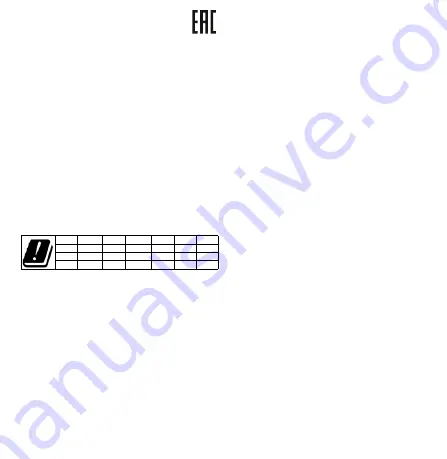
Regulatory Information
Wireless Adapter Regulatory Information
Use on aircraft
Caution: FCC and FAA regulations prohibit airborne operation of radio
frequency wireless devices (wireless adapters) because their signals could
interfere with critical interfere with critical aircraft instruments.
The Wireless Adapter and Your Health
The wireless adapter, like other radio devices, emits radio frequency electromagnetic
energy. The level of energy emitted by the wireless adapter, however, is less than the
electromagnetic energy emitted by other wireless devices such as mobile phones.
The wireless adapter operates within the guidelines found in radio frequency safety
standards and recommendations.
These standards and recommendations reflect the consensus of the scientific
community and result from deliberations of panels and committees of scientists who
continually review and interpret the extensive research literature. In some situations
or environments, the use of the wireless adapter may be restricted by the proprietor
of the building or responsible representatives of the applicable organization.
Examples of such situations may include:
- Using the wireless adapter on board airplanes, or
- Using the wireless adapter in any other environment where the risk of interference
with other devices or services is perceived or identified as being harmful.
If you are uncertain of the policy that applies to the use of wireless adapters in a
specific organization or environment (an airport, for example), you are encouraged to
ask for authorization to use the adapter before you turn it on.
This device is restricted to indoor operation only in the band 5150 - 5350 MHz. (Only
for devices that support 802.11 5 GHz functions)
European Union
List of applicable countries
This product must be used in strict accordance with the regulations and constraints in
the country of use. For further information, contact the local office in the country of
use. Please see
http://ec.europa.eu/enterprise/rtte/implem.htm
for the latest
country list.
This equipment complies with the essential requirements of the European Union
directive 2014/53/EU. See Statements of European Union Compliance, and more
details refer to the attached Declaration of Conformity.
This device is restricted to indoor use only when operating in the 5150 to 5350
MHz frequency range.
Italy
The use of these equipments is regulated by:
1.
D.L.gs 1.8.2003, n. 259, article 104 (activity subject to general authorization)
for outdoor use and article 105 (free use) for indoor use, in both cases for
private use.
2.
D.M. 28.5.03, for supply to public of RLAN access to networks and telecom
services.
Belgium
Dans le cas d'une utilisation privée, à l'extérieur d'un bâtiment, au-dessus d'un
espace public, aucun enregistrement n'est nécessaire pour une distance de moins de
300m. Pour une distance supérieure à 300m un enregistrement auprès de l'IBPT est
requise. Pour les enregistrements et licences, veuillez contacter l'IBPT.
In geval van privé-gebruik, buiten een gebouw, op een openbare plaats, is geen
registratie nodig, wanneer de afstand minder dan 300m is. Voor een afstand groter
dan 300m is een registratie bij BIPT vereist. Voor registraties en licenties, gelieve
BIPT te contacteren.
Pakistan
Pakistan Telecommunication Authority (PTA) Approved
Morocco
The operation of this product in the radio channel 2 (2417 MHz) is not authorized in
the following cities: Agadir,Assa-Zag, Cabo Negro, Chaouen, Goulmima, Oujda, Tan
Tan, Taourirt, Taroudant and Taza.
The operation of this product in the radio channels 4, 5, 6 and 7 (2425 - 2442 MHz) is
not authorized in thefollowing cities:
Aéroport Mohamed V, Agadir, Aguelmous, Anza, Benslimane, Béni Hafida, Cabo
Negro, Casablanca, Fès, Lakbab, Marrakech, Merchich, Mohammédia, Rabat, Salé,
Tanger, Tan Tan, Taounate, Tit Mellil, Zag.
SAR information
RF exposure information (SAR)
This device meets the EU requirements (2014/53/EU) on the limitation of exposure of
the general public to electromagnetic fields by way of health protection. The limits are
part of extensive recommendations for the protection of the general public. These
recommendations have been developed and checked by independent scientific
organizations through regular and thorough evaluations of scientific studies. To
guarantee the safety of all persons, regardless of age and health, the limits include a
significant safety buffer.
Before radio devices can be put in circulation, their agreement with European laws or
limits must be confirmed; only then may the CE symbol be applied.
The unit of measurement for the European Council's recommended limit for mobile
devices is the "Specific Absorption Rate" (SAR). This SAR limit is 2.0 W/kg, averaged
over 10 g of body tissue. It meets the requirements of the International Commission
on Non-Ionizing Radiation Protection (ICNIRP). The maximum SAR value is
calculated at the highest output level in all frequency bands of the mobile device. The
highest SAR value reported under this standard during product certification for use of
the device at a distance of 0 cm from the body.
During use, the actual SAR level is usually much lower than the maximum value,
because the mobile device works in different output levels. It only transmits with as
much output as is required to reach the network. In general the following applies: The
closer you are to a base station, the lower the transmission output of your mobile
device.
AT
BE
BG
HR
CY
CZ
DK
EE
FI
FR
DE
EL
HU
IE
IT
LV
LT
LU
MT
NL
PL
PT
RO
SK
SI
ES
SE
UK
Содержание EUT110-11A
Страница 1: ...ENDURO Urban T1 EUT110 11A Product and safety information ...
Страница 5: ......
Страница 11: ...acer com NC ROM11 000 NC ROM11 000 ...





























